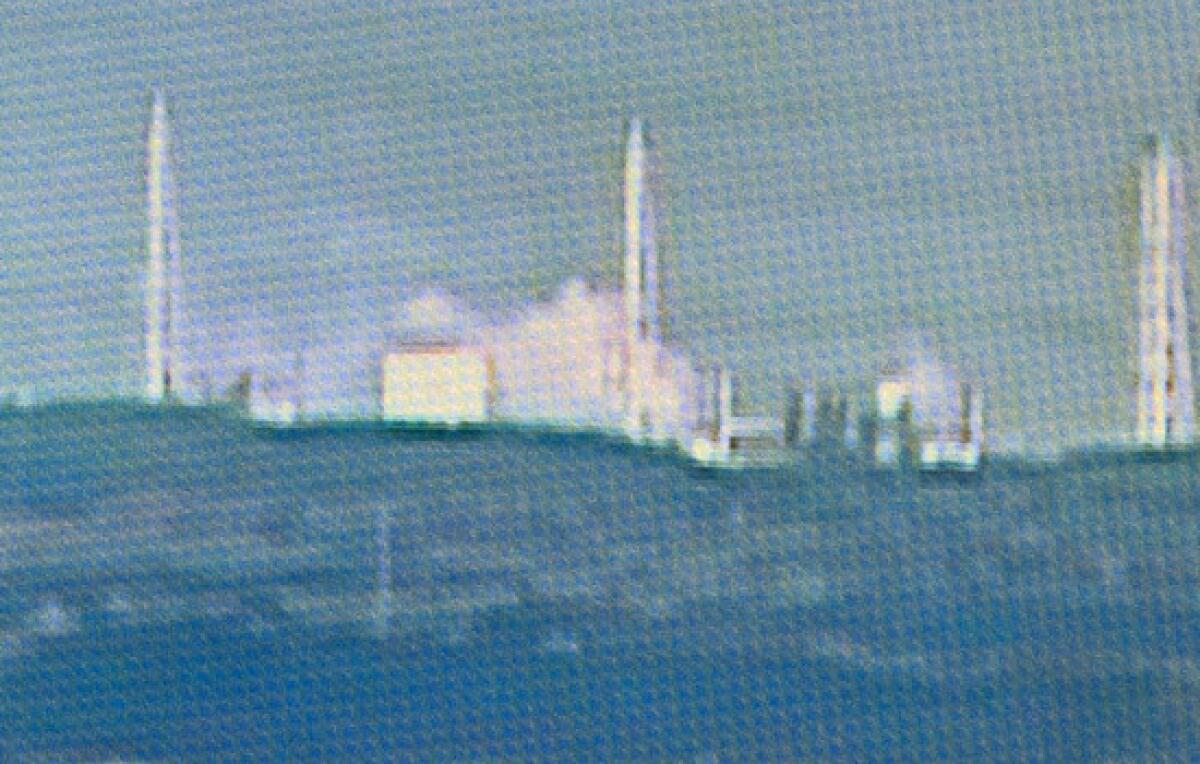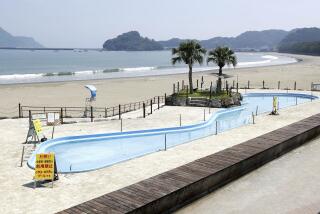Radiation spikes add to nuclear peril in Japan

- Share via
Reporting from Sendai and Tokyo, Japan — A series of grim developments hit a shaken Japan on Wednesday, including reports that high-level radiation may have leaked from a second damaged nuclear reactor and emergency workers being forced to temporarily abandon the crippled complex.
The setbacks aggravated public fears that authorities might not be able to contain the expanding nuclear crisis.
Japan’s chief Cabinet secretary, Yukio Edano, said radioactive steam might have escaped from the containment unit of a second reactor at the Fukushima No.1 (Daiichi) plant 150 miles north of Tokyo. The announcement followed unsettling news that a midmorning surge in radiation had forced emergency workers to halt their efforts to try to avert a meltdown of three other reactors at the plant, work that included the crucial task of keeping water on the reactors’ overheated cores.
Photos: Scenes of earthquake destruction
The burgeoning crisis has imposed a deepening isolation on the earthquake- and tsunami-battered country, with foreigners fleeing in growing numbers, rescue crews mindful of exit routes and international flights being diverted from the capital.
Another quake, centered off the coast near Tokyo and given a preliminary magnitude of 6, jolted the capital shortly after Edano’s announcement, further fraying nerves.
In the country’s north, tens of thousands of residents within about a 20-mile radius of the Fukushima plant were essentially trapped indoors for a second day Wednesday, urged again by authorities to avoid going out unless it was an emergency. That confinement coincided with growing hardship across the quake zone, where temperatures have dropped and snow fell overnight.
“Yesterday we ate a bit of rice and one egg,” said Yoshiko Tsuzuki, 55, a homemaker waiting in a line outside a grocery store on the outskirts of the battered city of Sendai. “We’re hungry. I want to buy water and anything to eat. We need everything.”
It remained unclear why a nation renowned for its efficiency has been unable to marshal convoys of supply trucks into the disaster area, as China did after its 2008 earthquake. Though military vehicles were evident, few emergency supplies were seen on the major arteries from Tokyo into the hard-hit Tohuku region and other seriously affected areas.
Even in cities that lie well outside the quake zone, daily life was increasingly disrupted by rolling blackouts and the curtailment of Japan’s much-vaunted transportation network, both of which will be key to restarting the engine of the world’s third-largest economy.
Stock prices stabilized Wednesday after tumbling for two days, but there was deepening gloom over the long-term financial outlook after the worst earthquake in the country’s recorded history, a concern even among people who have far more immediate and pressing fears.
“I’m worried in the long term about Japan’s economy,” said Yoshiko Konno, in her 60s, as she charged her cellphone at a community center in Sendai. “Just think of one example: oysters! Are Americans and Europeans going to want to import Japanese oysters if they think there is a danger of radioactive contamination?”
Five days later, the true scale of the disaster is still unknown.
At least 10,000 people are feared dead, a tally that is expected to take weeks to finalize. About half a million others have been displaced by quake and tsunami damage or the evacuation triggered by the emergency at Fukushima, a once-obscure nuclear plant that is now the focus of worldwide attention.
The cause of a blaze that erupted earlier Wednesday at the Unit 4 reactor — also the scene of a fire the day before — was not immediately known. The plant’s operator, Tokyo Electric Power Co., known as Tepco, said radiation levels were too high for firefighters to get close.
Later, authorities said the blaze seemed to be subsiding on its own, as the one the previous day did. But hours later, public television broadcaster NHK showed live aerial video of a plume of white smoke rising from the reactor.
At the plant, desperate and improvisational measures have become the rule.
Tepco said it abandoned as impractical the idea of using a helicopter to douse a boiling storage pool filled with spent fuel rods. The spent rods are usually submerged in the pool next to the Unit 4 reactor, which was not operating when the quake struck.
Dozens of emergency workers were pulled from the plant after radiation soared to levels that could cause radiation sickness. It later subsided, and hours later the workers returned.
Tepco has been sharply criticized for its handling of the crisis at the plant, where three of the six reactors have been rocked by explosions caused by overheating in their core containment chambers. The quake and tsunami knocked out power to the cooling systems, triggering a series of breakdowns and missteps that exposed fuel rods to the air at one reactor and released dangerous levels of radiation outside the plant.
The company said an estimated 70% of the fuel rods had been damaged at the Unit 1 reactor and 33% at the Unit 2 reactor. Nuclear safety agency spokesman Shigekatsu Omukai said the utility reported the figures to the agency Wednesday.
On Tuesday, the fuel rods inside the Unit 2 reactor were at least partly exposed to air for more than two hours during two separate incidents, allowing them to heat up and causing a buildup of hydrogen gas that burst into flames.
Spent fuel at the complex is an increasing focus of concern. Tepco had moved all of the rods from the Unit 4 reactor to the spent-fuel pool sometime after Dec. 1 as part of routine maintenance, meaning the pool contained not only all of the rods accumulated from many years of service but also all of those currently in use.
If the pool was jam-packed with rods, they would generate significant heat and, once the water stopped circulating after the tsunami, its temperature would begin rising, eventually reaching the boiling point. If the water boiled long enough without being replenished, it would expose the rods to the air.
In 2006, the National Academy of Sciences issued a report warning that a loss of cooling water or circulation could trigger a catastrophic fire in a spent-fuel pool that would result in large releases of radioactive material. If the rods become exposed to the air, their zirconium tubes begin to react with oxygen and heat up even more, a type of oxidation fire. At some point, the material inside the tubes melts and can release highly radioactive isotopes such as cesium-137 and iodine-131.
The report was prompted by concern about a potential terrorist attack, but the physics would be exactly the same in the case of a loss of coolant from a natural disaster, said Kevin Crowley, director of the nuclear and radiation studies board at the National Academies, who headed the study. The potential for a worst-case outcome in any kind of incident depends on how closely the rods are packed, the age of the rods, the size of the pool and how much fuel is in the pool, Crowley said.
“I think everybody should be worried about this situation,” he said.
Uncertainty about the risks posed by the stricken plant caused nations coming to Japan’s aid to pull back and reassess deployment of rescue personnel, relief supplies and transportation services. The U.S. aircraft carrier Ronald Reagan, which steamed to the rescue over the weekend, pulled back from Japan’s northeastern shore Tuesday after detecting elevated radiation levels in the atmosphere.
Some international airlines that had resumed flying to Tokyo halted or rerouted service again Tuesday to guard against entering areas with heightened radiation. Germany’s Lufthansa, Austrian Airlines, Air France-KLM and others — European carriers still wary of radiation hazards 25 years after the Chernobyl disaster — cited the risk of nuclear contamination and the persistent aftershocks in canceling or delaying flights.
In China, officials said safety experts would monitor planes and ships arriving at its ports for radioactivity. China also announced it was evacuating its citizens from Japan’s northeast, becoming the first nation to organize a massive relocation because of the radiation fears.
France also recommended that its citizens leave the Japanese capital, and Austria announced it was moving its embassy from Tokyo to Osaka to distance its diplomats from any worsening of the crisis.
The U.S. government has recommended that Americans cancel any nonessential travel to Japan and that those already in the country heed the advice and direction of Japanese officials.
Photos: Scenes of earthquake destruction
Magnier and Demick reported from Sendai, King from Tokyo.
Special correspondent Kenji Hall in Tokyo and Times staff writers Carol J. Williams, Ralph Vartabedian and Thomas H. Maugh II in Los Angeles contributed to this report.
More to Read
Sign up for Essential California
The most important California stories and recommendations in your inbox every morning.
You may occasionally receive promotional content from the Los Angeles Times.










